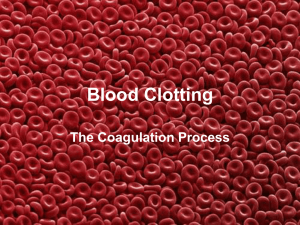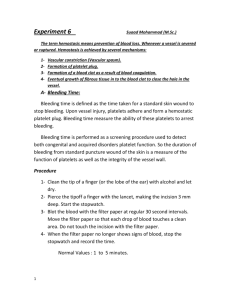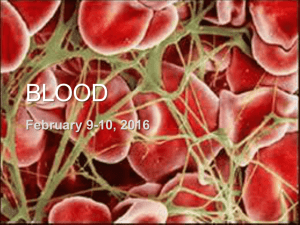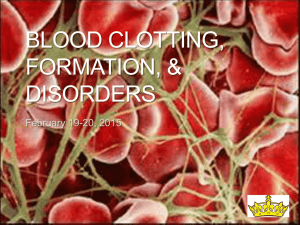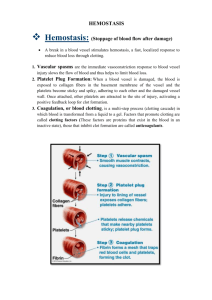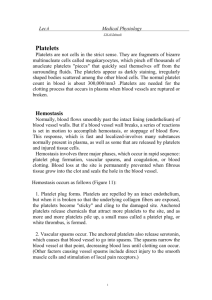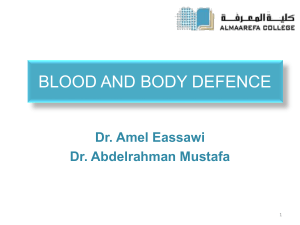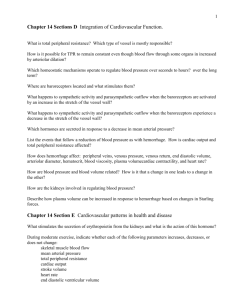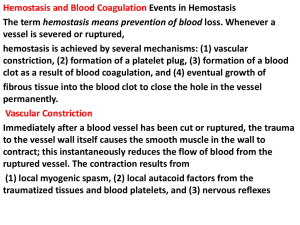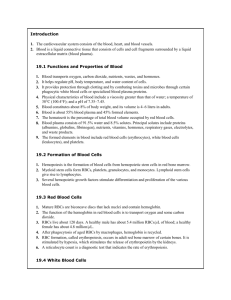Hemostasis
advertisement
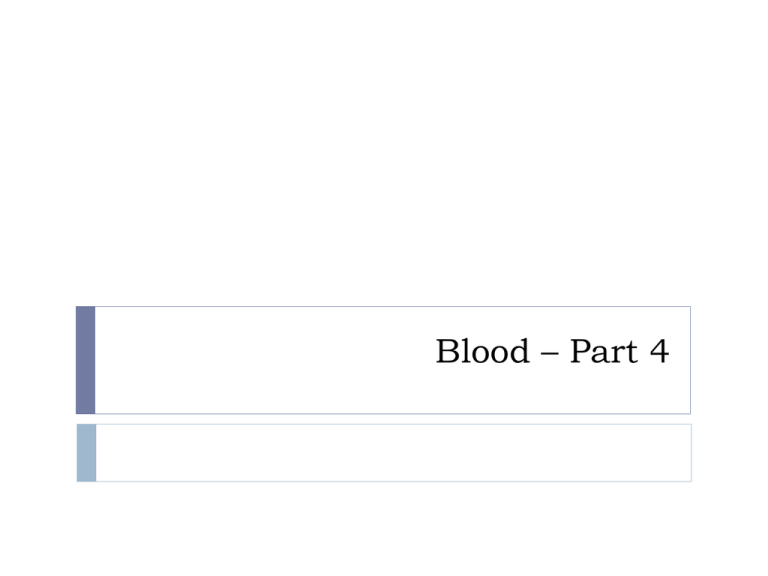
Blood – Part 4 Hemostasis Hemostasis – Stoppage of blood flow. If a blood vessel wall breaks a series of reactions is set in motion. This response is fast and localized. Involves many substances that are normally present in the plasma, as well as some that are released by platelets and injured tissue cells. Phases of Hemostasis Hemostasis involves three major phases, which occur in rapid sequence: 1. 2. 3. Platelet plug formation Vascular spasms Coagulation (blood clotting) Blood loss at the site is permanently prevented when fibrous tissue grows into the clot and seals the hole in the blood vessel. 1. Platelet Plug Formation When the endothelium is broken, the platelets become “sticky” and cling to the damaged site. Anchored platelets release chemicals that attract more platelets to the site, and as more and more platelets pile up, a small mass called a platelet plug is formed. 2. Vascular Spasms Occur The anchored platelets also release serotonin, which causes the blood vessels to go into spasms. The spasms narrow the blood vessel at that point, decreasing blood loss until clotting can occur. 3. Coagulation Events Occur At the same time, the injured tissues are releasing thromboplastin, a factor that plays a role in clotting. PF3 (a phospholipid that coats the surfaces of the platelets) interacts with the following to form an activation that triggers the clotting cascade: 1. 2. Thromboplastin Other blood clotting factors Calcium ions 3. Coagulation Events Occur 3. 4. This prothrombin activator converts prothrombin (present in the plasma) to thrombin (an enzyme). Thrombin then joins soluble fibrinogen proteins into long hairlike molecules of insoluble fibrin, which forms a meshwork that traps the RBCs and forms the basis of the clot. 3. Coagulation Events Occur 5. Within the hour the clot begins to retract, squeezing serum (plasma minus the clotting proteins) from the mass and pulling the ruptured edges of the blood vessel closer together. Blood Clotting Normally, blood clots within 3-6 minutes. Once the clotting cascade has started, the triggering factors are rapidly inactivated to prevent widespread clotting. Eventually, the endothelium regenerates and the clot is broken down. Placing gauze over a cut speeds up the clotting process. The gauze provides a rough surface to which the platelets and cells can adhere to. Disorders of Hemostasis The two major disorders of hemostasis include: 1. 2. Undesirable Clot Formation Bleeding Disorders Undesirable Clotting Despite the body’s safeguards against abnormal clotting, undesirable clots sometimes form in intact blood vessels, particularly in the legs. Thrombus – A clot that develops and persists in an unbroken blood vessel. If large enough, it may prevent blood flow to the cells beyond the blockage. Embolus – A thrombus that breaks away from the vessel wall and floats freely. Usually not a problem unless or until it lodges in a blood vessel too narrow for it to pass through. Causes of Undesirable Clotting May be caused by anything that roughens the endothelium of a blood vessel. 1. Roughening of the endothelium encourages clinging of platelets. Such as severe burns, physical blows, or an accumulation of fatty material. Causes of Undesirable Clotting (Cont.) Another risk factor is slowly flowing blood or blood pooling (especially in immobilized patients). 2. Clotting factors are not washed away as usual and accumulate so that clot formation becomes possible. Anticoagulants A number of anticoagulants are used clinically for thrombus-prone patients: Aspirin Heparin Dicumarol
